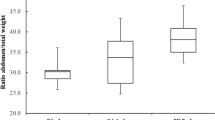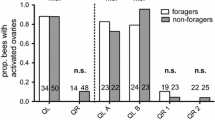Abstract.
The honey bee originated in tropical Africa and later dispersed to northern Europe. It has been suggested that a higher hemolymph storage capacity for the glycolipoprotein vitellogenin evolved in temperate regions, and that the trait constitutes an adaptation to a strongly seasonal environment. We have investigated whether the relative vitellogenin levels of European and African honey bees are in accordance with this hypothesis. Our data indicate that European workers have a higher set-point concentration for vitellogenin compared to their African origin. Considered together with available life history information and physiological data, the results lend support to the view that “winter bees”, a longlived honey bee worker caste that survives winter in temperate regions, evolved through an increase in the worker bees’ capacity for vitellogenin accumulation.
Similar content being viewed by others
Author information
Authors and Affiliations
Corresponding author
Additional information
Received 20 September 2004; revised 25 March 2005; accepted 13 April 2005.
Rights and permissions
About this article
Cite this article
Amdam, G.V., Norberg, K., Omholt, S.W. et al. Higher vitellogenin concentrations in honey bee workers may be an adaptation to life in temperate climates. Insect. Soc. 52, 316–319 (2005). https://doi.org/10.1007/s00040-005-0812-2
Issue Date:
DOI: https://doi.org/10.1007/s00040-005-0812-2




